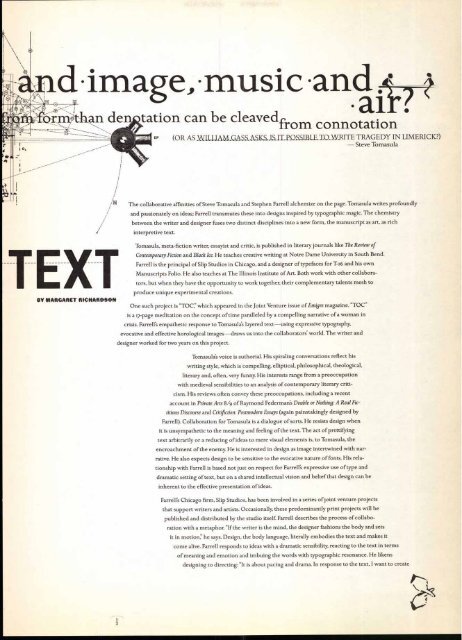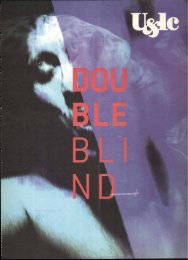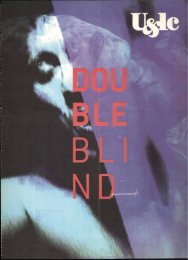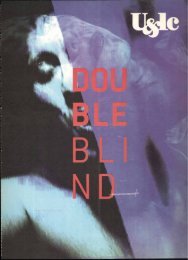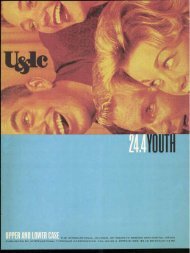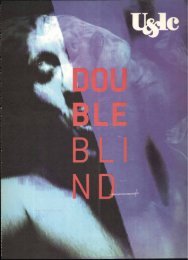You also want an ePaper? Increase the reach of your titles
YUMPU automatically turns print PDFs into web optimized ePapers that Google loves.
d'image,musicand<br />
.air?<br />
mAhan de station can be cleaved from connotation<br />
TE BY MARGARET RICHARDS**<br />
IPLA;'H<br />
The collaborative affinities of Steve Tomasula and Stephen Farrell alchemize on the page. Tomasula writes profoundly<br />
and passionately on ideas; Farrell transmutes these into designs inspired by typographic magic. The chemistry<br />
between the writer and designer fuses two distinct disciplines into a new form, the manuscript as art, as rich<br />
interpretive text.<br />
EP (OR AS liVILLIAIYLGASS_ASKSJS_IT_PDSSIBLEIO_WRITE TRAGEDY IN LIMERICK?)<br />
— Steve Tomasula<br />
Tomasula, meta-fiction writer, essayist and critic, is published in literary journals like The Review of<br />
Contemporary Fiction and Black Ice. He teaches creative writing at Notre Dame University in South Bend.<br />
Farrell is the principal of Slip Studios in Chicago, and a designer of typefaces for T-26 and his own<br />
Manuscripts Folio. He also teaches at The Illinois Institute of Art. Both work with other collabora-<br />
tors, but when they have the opportunity to work together, their complementary talents mesh to<br />
produce unique experimental creations.<br />
One such project is "TOC' which appeared in the Joint Venture issue of Emigre magazine "TOC"<br />
is a 17-page meditation on the concept of time paralleled by a compelling narrative of a woman in<br />
crisis. Farrell's empathetic response to Tomasula's layered text—using expressive typography,<br />
evocative and effective horological images draws us into the collaborators' world. The writer and<br />
designer worked for two years on this project.<br />
Tomasula's voice is authorial. His spiraling conversations reflect his<br />
writing style, which is compelling, elliptical, philosophical, theological,<br />
literary and, often, very funny. His interests range from a preoccupation<br />
with medieval sensibilities to an analysis of contemporary literary criti-<br />
cism. His reviews often convey these preoccupations, including a recent<br />
account in Private Arts 8/9 of Raymond Federman's Double or Nothing: A Real Fic-<br />
titious Discourse and Critifiction: Postmodern Essays (again painstakingly designed by<br />
Farrell). Collaboration for Tomasula is a dialogue of sorts. He resists design when<br />
it is unsympathetic to the meaning and feeling of the text. The act of prettifying<br />
text arbitrarily or a reducing of ideas to mere visual elements is, to Tomasula, the<br />
encroachment of the enemy. He is interested in design as image intertwined with nar-<br />
rative. He also expects design to be sensitive to the evocative nature of fonts. His rela-<br />
tionship with Farrell is based not just on respect for Farrell's expressive use of type and<br />
dramatic setting of text, but on a shared intellectual vision and belief that design can be<br />
inherent to the effective presentation of ideas.<br />
Farrell's Chicago firm, Slip Studios, has been involved in a series of joint venture projects<br />
that support writers and artists. Occasionally, these predominantly print projects will be<br />
published and distributed by the studio itself. Farrell describes the process of collabo-<br />
ration with a metaphor. "If the writer is the mind, the designer fashions the body and sets<br />
it in motion: he says. Design, the body language, literally embodies the text and makes it<br />
come alive. Farrell responds to ideas with a dramatic sensibility, reacting to the text in terms<br />
of meaning and emotion and imbuing the words with typographic resonance. He likens<br />
designing to directing: "It is about pacing and drama. In response to the text, I want to create


